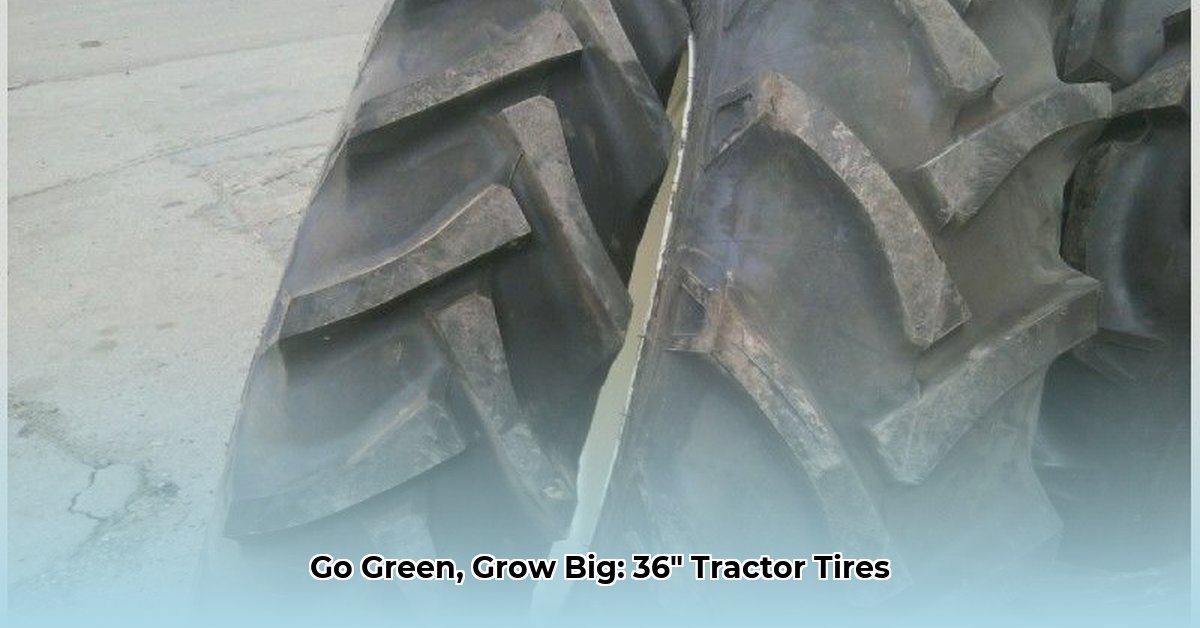
Choosing the right tractor tires significantly impacts farm efficiency, profitability, and environmental sustainability. This guide focuses on 36-inch tractor tires, offering practical advice for selection, maintenance, and responsible disposal. For more information on specific tire sizes, check out this helpful resource on 41x14 tractor tires.
Understanding Tractor Tire Sizing: Past and Present
Historically, tractor tire sizing was straightforward, using whole numbers like "36 inches." However, this lacked the precision needed for modern agriculture. Modern systems incorporate decimals, offering greater accuracy. This transition can be confusing, but understanding both systems is crucial for making informed decisions. Manufacturers' websites (such as Morrow Tire and Pete's Tire Store) often provide resources to translate between these systems. This knowledge is vital for avoiding costly mistakes and ensuring optimal performance.
Selecting the Right 36-Inch Tractor Tire: A Step-by-Step Approach
Choosing the correct tire size is a process, not a guess. Incorrect tire sizing directly impacts fuel efficiency, soil health, and overall farm sustainability.
- Consult Your Tractor's Manual: Your owner's manual provides recommended tire sizes for optimal performance and safety. This is the most reliable starting point.
- Inspect Existing Tires (If Applicable): The sidewalls of your current tires (if replacing) contain size markings. Note that older markings differ from modern decimal systems.
- Utilize Online Resources: Many tire suppliers offer cross-referencing tools and size charts to assist in translating between older and newer sizing systems.
- Consider Terrain and Workload: Different soil types and farming tasks require different tire characteristics. Heavier soils may benefit from wider tires to minimize compaction, while lighter soils may allow for narrower tires. Consider the specific demands of your operation.
Negative Impacts of Incorrect Tire Sizing: Environmental and Economic Costs
Using improperly sized tires generates many negative consequences, impacting both your bottom line and the environment:
Increased Fuel Consumption: Poor traction from undersized or oversized tires forces your tractor to work harder, increasing fuel consumption and greenhouse gas emissions. This translates to higher operating costs and a larger carbon footprint. How much extra fuel are you wasting? The answer depends on your specific situation, but the impact is significant.
Soil Compaction: Inadequate tire sizing can compact the soil, reducing water infiltration and aeration. This negatively impacts plant growth, yielding lower harvests and long-term soil degradation. The consequences of soil compaction extend beyond a single growing season.
Reduced Traction: Insufficient traction results in increased wheel slip, leading to decreased productivity and potential damage to equipment. A simple calculation can show you how much time and therefore money you are losing each year.
Premature Tire Wear: Incorrect sizing accelerates tire wear, resulting in more frequent replacements and increased waste generation. This additional waste requires responsible disposal and contributes to the environmental burden of farming practices.
Maintaining Your 36-Inch Tractor Tires: Practical Tips for Longevity
Regular tire maintenance significantly extends their life and ensures optimal performance. These simple steps can make a substantial difference:
Regular Inflation Checks: Employ a reliable pressure gauge and consistently maintain the recommended inflation pressure (found on the tire sidewall or in your tractor's manual). Maintaining correct pressure is crucial for tire longevity and safety.
Frequent Inspections: Regularly inspect your tires for cuts, bulges, or any signs of damage. Early detection of small issues prevents larger, more costly repairs later.
Appropriate Storage: When not in use, store your tires in a clean, cool, dry location, away from direct sunlight and extreme temperatures. This protects against damage and premature aging.
Sustainable Tire Disposal: Responsible End-of-Life Management
Disposing of old tires responsibly protects the environment. Instead of discarding them improperly, consider these options:
- Recycling Programs: Many local and regional programs accept used tires for recycling or repurposing.
- Retreading: In some situations, retreading your tires is a cost-effective and sustainable alternative to complete replacement.
Remember, responsible disposal not only benefits the environment but also demonstrates your commitment to sustainable agricultural practices.
Further Resources and Information
This guide provides a foundation for understanding 36-inch tractor tire selection and maintenance. For more in-depth information, consult your local agricultural extension office, reputable agricultural publications, or the websites of major tire manufacturers. Always stay informed. Continuously learning and optimizing your practices contribute to a more efficient, productive, and greener farming operation.